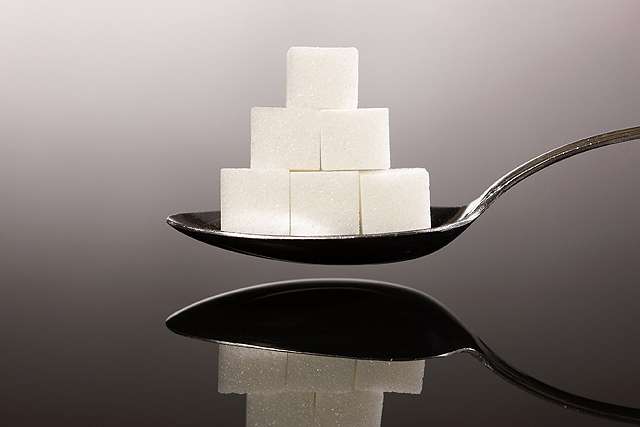The 2015 Dietary Guidelines for Americans recommends limiting added sugars. Credit: Peggy Greb
Whether all sweeteners produce the same metabolic effects in consumers is a controversial topic. A study conducted by Agricultural Research Service (ARS) investigators indicates that consuming lower amounts of added sugars is a more effective approach to health than finding a sugar that is more neutral in terms of its health effects.
High fructose corn syrup (HFCS) sprang to market as a cheaper source of added sugar in the 1970s. By the year 2000, HFCS and white table sugar (sucrose) were being consumed about equally. Honey, which has been used for centuries as a sweetener, became less used when table sugar became more used. Overall, per-person consumption of added sugars in the United States increased throughout the 1900s.
The chemical similarities among the different sweeteners studied provide a hint about the results. Sugar, HFCS, and honey contain glucose and fructose, but in slightly different proportions. Table sugar (whether from cane or beet) contains about 50 percent glucose and 50 percent fructose. Much HFCS (including that used in the study) contains about 45 percent glucose and 55 percent fructose. Different honeys have different proportions of glucose to fructose; those richer in fructose taste sweeter
ARS nutritionist Susan Raatz and her colleagues at the Grand Forks Human Nutrition Research Center in Grand Forks, North Dakota, investigated whether any of the sweeteners is more nutritionally beneficial than the others. Her team studied the metabolic and health effects of chronically consuming HFCS, sugar, and honey in people with impaired glucose tolerance (pre-diabetes) and in people with normal glucose tolerance. Volunteers with glucose intolerance were included because they may be particularly vulnerable to negative metabolic effects of added sugars, including heart disease risks, elevated blood fats and blood pressure, and inflammation.
The study consisted of 2 groups: 27 volunteers with glucose intolerance and 28 volunteers with normal glucose tolerance. Their study diets incorporated 50 grams of carbohydrates daily from one of the three sweeteners: honey, white cane sugar, or HFCS. Over the course of the study, each of the sweeteners was fed to each of the volunteers for a 2-week period. Substituting the sweeteners for other carbohydrates in the diet allowed the volunteers to maintain their weight.
Volunteers in the two groups did not show any differences in blood sugar levels based on the dietary sugar source. In addition, the three sugar sources resulted in the same increased levels of triglycerides. "Blood levels of triglyceride, used as an indicator of blood fat concentrations—a marker for heart disease risk—increased in response to all three sugars tested," says Raatz.
Results of the study were published in the October 2015 issue of the Journal of Nutrition.
The 2015 Dietary Guidelines for Americans (DGAs) Advisory Committee emphasized evidence showing that high consumption of added sugars increases the risk of type 2 diabetes among adults. The study provides support for the guidelines, and the newly released 2015 DGAs recommend "an eating pattern low in added sugars."
Journal information: Journal of Nutrition
Provided by Agricultural Research Service



















